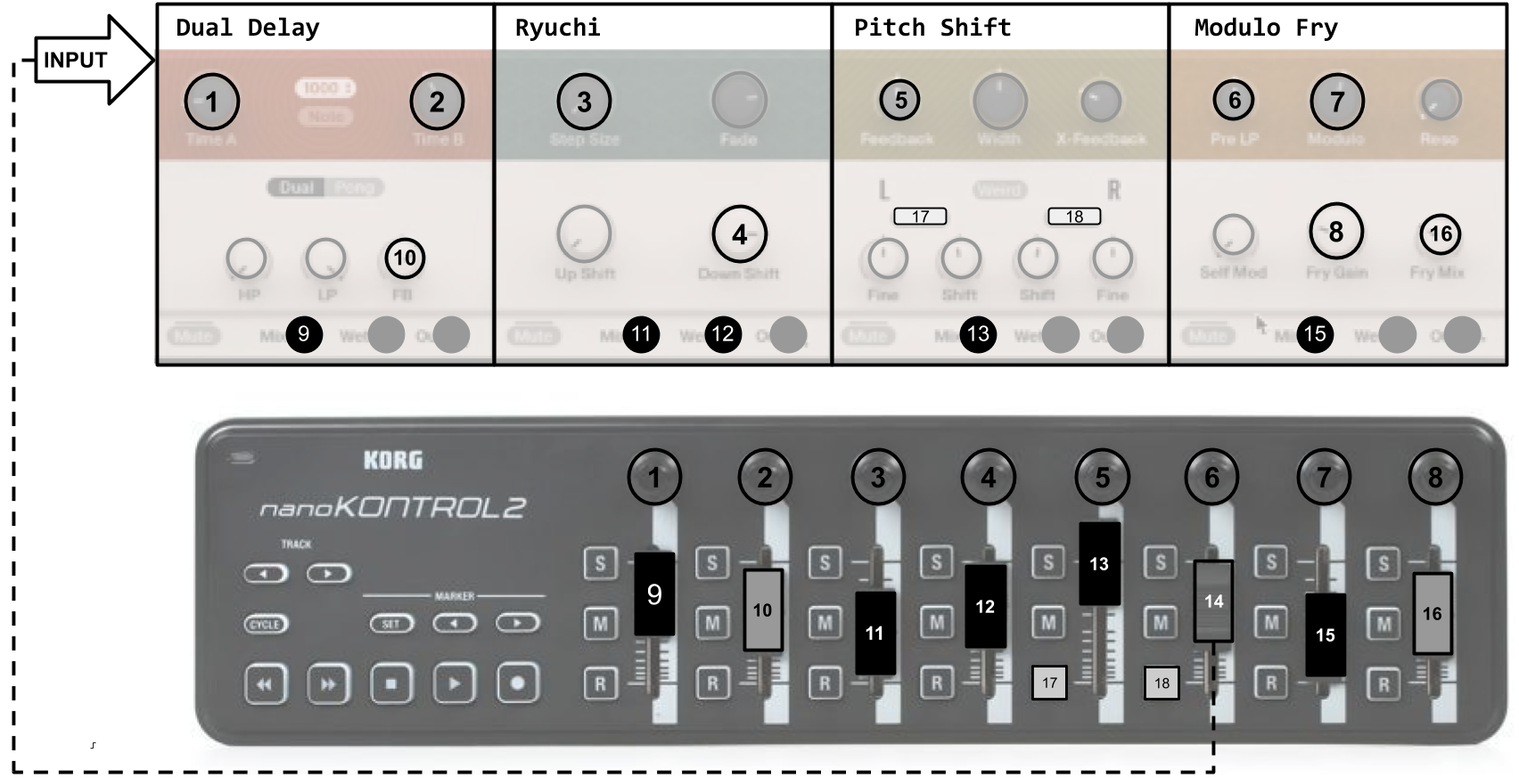While improvisers and composers working with live electronics draw on similar musical resources, there is a clear ideological divide when it comes to the role of rehearsal and preparation and how they relate to the concept of a musical work. In our case, Adrián and I regard aubiome as a work, albeit a somewhat flexible one. Our decision to set aside dedicated rehearsal time during which no structural changes to the system or the piece are permitted appears significant. If the previous working phases encroach on the rehearsal period too much, we may never arrive at a fixed piece that can be rehearsed, repeated and prepared. At some point, however arbitrary, we need to declare the piece to be finished. This can be a stressful moment in the creative process, and many composers would struggle to reach this point without external deadlines and rehearsal schedules to force their hand. Our cyclical, work-in-progress model alleviates this anxiety by recognizing that each ‘finished’ piece is one step in a larger process.
Our performer-centric approach to collaboration has primarily focused on incorporating the performer as a co-author of new musical works into the creative process. An unexpected consequence of this was that Adrián has gradually taken on the role of co-performer. Adrián has gradually become an indispensable part of the performance as the project has grown, our system has become more complex, and our music has become more ambitious and nuanced. As a consequence of adopting an active role on stage, Adrián has had a certain shift in perspective, which has informed his approach to the ongoing aubiome aubiome project, as well as his overall compositional practice.
Adrián’s interface with the computer is a type of musical instrument in and of itself, and it has become increasingly complex and challenging to control over time. Whereas we designed the saxophone-computer links to expand on my instrument’s inherent musical nature, Adrián’s instrument has no prior musical pre-configuration of its own. His is a pure digital musical instrument (DMI), in which each link to the computer must be planned, built and then learned by the performer. Many of the performer-centric design principles that we have used to create the saxophone-computer system are also applicable to Adrián’s DMI. For example, an ongoing design challenge is to consider the physicality of his interface and how gesture translates to musical sound.
For decades, the difficulties associated with rehearsing electronic music, particularly pieces involving complex real-time processing, have been a recurring theme. While technological advancements have made it easier for composers and performers to gain access to powerful tools in this space, integrating them meaningfully into our performance practices can be a struggle. Often, performers do not have the opportunity (or interest) to work with the electronics system in advance. Without a basic understanding of how the computer functions, it is easy to fall into a performing style in which the computer and performers simply move through the piece in parallel. A common scenario occurs when the performer is instructed to simply execute his part while the electronics are handled separately, as a separate layer. Considering the constraints that composers and contemporary music ensembles face, the ‘parallel stream’ working method is a convenient solution. However, we believe that it misses some of the most interesting ways in which the computer can be used in live performance.
One alternative working model is our performer-centric approach. It is a much more natural step to rehearse and perform with the system if we prioritize performability from the start and generate music material through hands-on practice. We would like to see performer-based systems play a larger role in classical contemporary music, as they have in certain circles in free jazz for decades. Some improvisers have systems that are so well-developed and explored that they can be used for performance without any rehearsal. For example, in his description of his work with KaiBorg (in our interview (2021)) Jeff Kaiser mentions that they do not prepare any material or pre-planned structure. The question of whether or not to prepare material is part of a larger debate in free jazz, with some going so far as to declare it ‘cheating’ (Ryan 2021).
Mappings for Adrián's Digital Musical Instrument (DMI) when performing manifold
A rehearsal for aubiome might go as follows:
We have our first dedicated rehearsal day a week before the performance, after a long period of developing new musical material that forms two new movements we added to the piece for this event. We were working on the structure of the piece the night before, so we remind ourselves that it is now time to shift our attention to the upcoming performance.
We start working on the new movement and quickly notice that some of our musical ideas are not coming across as expected. As we imagine ourselves performing the piece in front of an audience, new challenges become clear. The temptation is to go back and change the underlying computer behavior, but instead we look for performance-based solutions. For example, Adrián could give a cue to help us coordinate our arrival at a certain event, whereas for another section, I should maintain a still body position to heighten the musical effect of the computer’s manipulation of my sound.
After working on the movement this way, we have addressed some of the big-picture issues, but there are still some technical challenges for both of us that require individual attention. We need to go through the movement again and record the direct saxophone sound for Adrián to be able to practice on his own. We agree to work separately the next day and then rehearse together in the evening, with the goal of being able to perform the entire movement uninterrupted.
As the concert date approaches, rehearsals shift to a focus on performing entire movements, and eventually the entire piece. While this description may seem obvious to classical musicians, the addition of a computer functioning in real-time often disrupts typical rehearsal patterns. If the computer cannot be smoothly integrated and rehearsed, that is an indication that something went wrong earlier in the process and will need to be reviewed for the next iteration.









